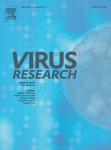Ver ítem
- xmlui.general.dspace_homeCentros e Institutos de InvestigaciónCICVyA. Centro de Investigación en Ciencias Veterinarias y AgronómicasInstituto de BiotecnologíaArtículos científicosxmlui.ArtifactBrowser.ItemViewer.trail
- Inicio
- Centros e Institutos de Investigación
- CICVyA. Centro de Investigación en Ciencias Veterinarias y Agronómicas
- Instituto de Biotecnología
- Artículos científicos
- Ver ítem
Differences in the virulence of two strains of Foot-and-Mouth Disease Virus Serotype A with the same spatiotemporal distribution
Resumen
During the 2000–2001 epidemic of Foot-and-Mouth Disease Virus (FMDV) in Argentina, two FMDV serotype A viruses were identified among others. Since different pathogenic properties between these virus strains were noticed in cattle, we evaluated several biological properties and features of FMDV A/Arg/00 and FMDV A/Arg/01 in order to compare these viruses in terms of virulence and pathogenicity. Our results indicate that FMDV A/Arg/00 grows less efficiently
[ver mas...]
During the 2000–2001 epidemic of Foot-and-Mouth Disease Virus (FMDV) in Argentina, two FMDV serotype A viruses were identified among others. Since different pathogenic properties between these virus strains were noticed in cattle, we evaluated several biological properties and features of FMDV A/Arg/00 and FMDV A/Arg/01 in order to compare these viruses in terms of virulence and pathogenicity. Our results indicate that FMDV A/Arg/00 grows less efficiently than FMDV A/Arg/01, exemplified by smaller sized plaques, retarded one-step growth curves and overall low viral yields. Also, FMDV A/Arg/00 displayed the lowest specific infectivity in suckling mice requiring 50-fold more infectious particles than FMDV A/Arg/01 to generate a LD50 in suckling mice. Finally, FMDV A/Arg/00 did not cause death in adult C57Bl/6 mice even at high doses (107–106 PFU) whereas FMDV A/Arg/01 resulted lethal in doses as low as 102 PFU. Overall, we were able to demonstrate that these virus strains differ from each other in terms of virulence and pathogenicity.
[Cerrar]

Fuente
Virus Research 147 (1) : 149-152 (January 2010)
Fecha
2010-01
Editorial
Elsevier
ISSN
0168-1702
Formato
pdf
Tipo de documento
artículo
Palabras Claves
Derechos de acceso
Restringido
 Excepto donde se diga explicitamente, este item se publica bajo la siguiente descripción: Creative Commons Attribution-NonCommercial-ShareAlike 2.5 Unported (CC BY-NC-SA 2.5)
Excepto donde se diga explicitamente, este item se publica bajo la siguiente descripción: Creative Commons Attribution-NonCommercial-ShareAlike 2.5 Unported (CC BY-NC-SA 2.5)

